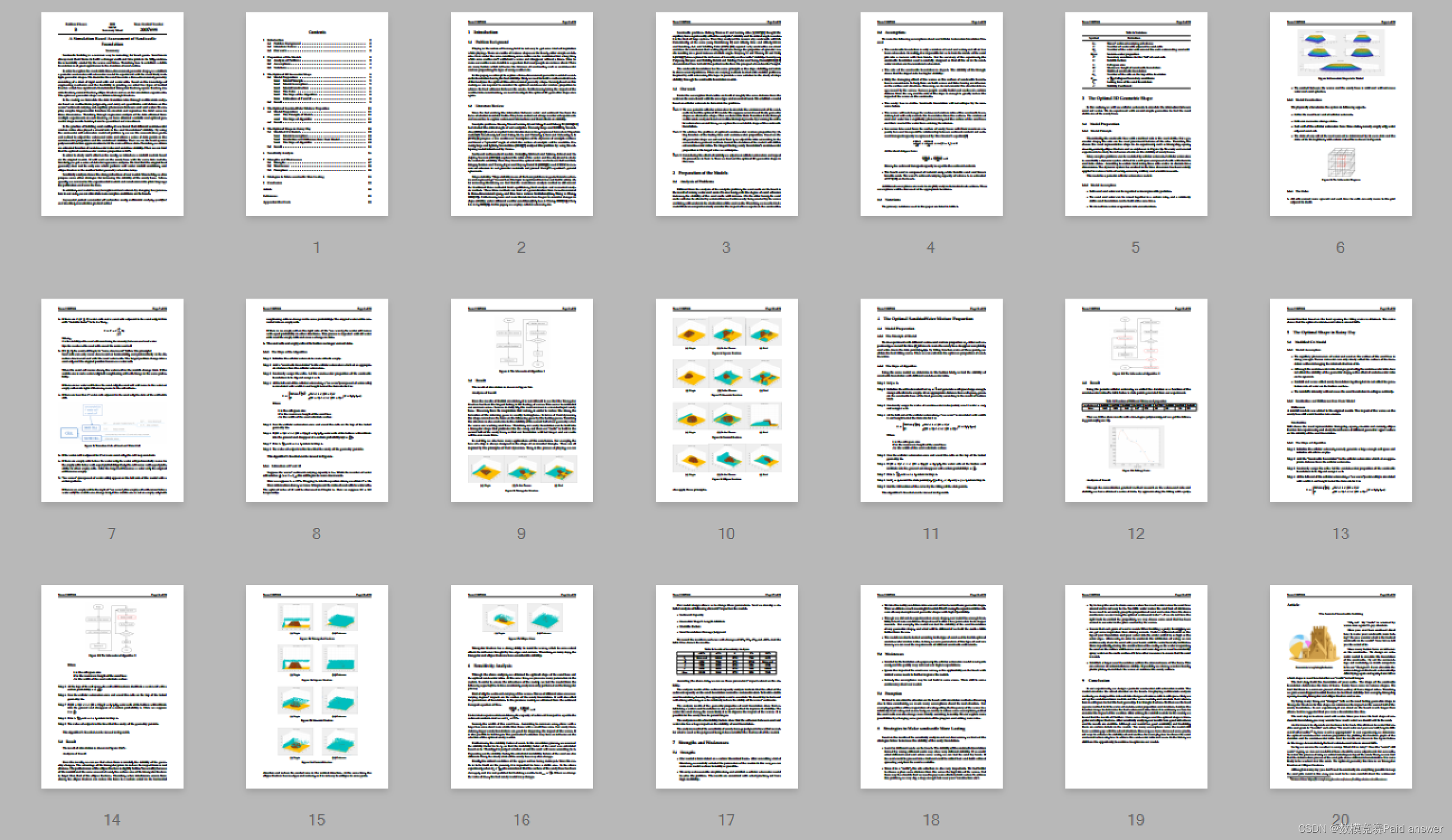2020年美国大学生数学建模竞赛
B题 持续保存时间最长的沙堡
原题再现:
无论世界上哪里的休闲沙滩,似乎都有儿童(和成人)在海边制作沙堡。通过使用工具,玩具和想象力,沙滩上的人们创造了沙堡,沙堡的范围从简单的沙丘到实际城堡的复杂复制品,包含墙壁,塔楼,护城河和其他模仿真实城堡的特征。所有的沙堡通常会形成一个初始的沙堡基础,该基础由一个单一的无形的湿沙丘组成,然后将其切割并成形为可识别的 3 维几何形状,从而在其上构建更具城堡意义的特征。
然而不可避免的是海浪的涌入以及潮汐的上升会侵蚀沙堡。但是,即使建造的沙丘大小并且距离同一海滩的水面大致距离相同,似乎并非所有沙堡对海浪和潮汐的反应都相同。因此,人们想知道是否存在用于沙堡基础的最佳 3 维几何形状。
要求
1. 构造一个数学模型以识别最佳的 3 维几何形状,以用作沙堡基础,该沙丘基础将在以下情况下在经历波浪和潮汐的海滨上持续最长的时间:
l 建在同一海滩上的距离水面大致相同的距离处
l 使用相同类型的沙子,大致相同的沙子量和相同的水沙比例建造。
2. 假设您不使用其他添加剂或材料(例如塑料或木制支撑物,石头等),请使用模型确定城堡基础的最佳水沙混合比例。
3. 根据以下需要调整模型,①确定问题 1 中确定的最佳 3 维沙堡基础如何受到雨水的影响,②以及在下雨时它是否仍保留为用作城堡基础的最佳 3 维几何形状。
4. 您还可以使用其他哪些策略来延长沙堡的保存持续时间?
5. 最后,写一篇内容丰富的一到两页的趣味性科普性文章,描述您的模型及其结果,以发表在度假杂志上:《Fun in the Sun》,该杂志读者主要是非技术性的。
整体求解过程概述(摘要)
沙堡建筑是海滩游客娱乐的常见方式。沙子爱好者总是绞尽脑汁建造一座更坚固的城堡并以此为荣。尽管如此,沙坑不可避免地被海浪和潮汐侵蚀。因此,如何建立稳定的基础,对沙堡的持续时间具有重要意义。
为了探索最稳定的三维几何形状,我们建立了一个周期性的砂水细胞自动机模型,以试验最有可能的多个几何形状。我们将砂底离散化为由一堆刚性砂细胞和水细胞组成的三维几何形状。基于工程力学知识和实践可行性,我们选取了五种具有显著特征的惯性视锥体:三角截锥、方形视锥、六阿里斯视锥、锥形视锥、椭圆视锥等进行仿真实验。我们得到的最佳几何形状是三角形视锥体。
在模型中,基于多准则判断,通过多元分析制定状态转移规律,对波浪的泥沙携带和沙水毛细现象进行定量计算。我们采用复杂的三角函数来模拟和再现三维潮汐波。因此,通过对每个视锥体的多次实验获得的数据进行回归分析,我们获得了可靠且最佳的几何形状结果。此外,它可以量化和可视化。
在建造沙堡的实践中,发现不同的砂水混合比对砂基础的稳定性也起着至关重要的作用。利用问题1的砂-水细胞自动机模型,采用浓度光度法调整水砂比,得到砂水比和砂基稳定性的一系列数据点。然后我们使用最小二乘多项式函数近似来拟合这些数据的曲线。因此,我们得到了砂水比和砂基稳定性的估计函数。然后我们可以发现,最佳的砂水混合比例为0.55。
为了研究降雨对结果的影响,我们引入了基于原始模型的降雨模块。它将在带有波潮模块的沙质底座上工作。同样,我们得到一系列用于回归分析的数据。我们发现,原始的最佳几何形状并不是唯一在降雨条件下表现良好的几何形状,椭圆视锥体是下雨时另一种更好的几何形状。
灵敏度分析表明我们的模型具有很强的鲁棒性。同时,我们还提出了一些其他策略来提高砂基的稳定性。随后,我们将实验模型和结论总结为通俗易懂的语言,以便在《阳光下的乐趣》上发表。
此外,我们的模型易于实现和扩展。通过更改代码中的几个参数,我们可以刺激海滩上更复杂的条件。
模型假设:
我们对元胞自动机模拟过程做出以下假设:
1.沙堡地基只是沙子和水的混合物,所有的空气都已经耗尽。实际上,我们不可能徒手将沙堆的内部变成真空。为了实验的准确性,所使用的沙堡基础经过精心设计,因此沙水混合物中的所有空气都可以认为是排气的。
2.沙堡地基的侧面是倾斜的。三角形的稳定性表明倾斜边具有较高的稳定性。
3.只考虑海浪对沙堡表面的破坏作用。事实上,波浪和潮汐对表面和结构都有影响。然而,我们没有考虑海浪造成的结构性破坏。因为人们通常把沙堡建在离海一定距离的地方,坡的侧面足以大大减少海浪对沙堡的影响。
4.沙质基质稳定。沙堡地基不会因非波浪因素而倒塌。
5.海浪不会改变沙堡地基的水沙混合比例,只会从地表腐蚀地基。沙子和水的混合物具有毛细现象,砂底的表面可以阻挡大部分水进入内部。
6.海浪从沙质基质表面以最大的沙子运输能力吸收沙子。
问题重述:
假设城堡建在同一海滩上与水的距离大致相同,沙子类型和数量相同。我们建立了一个基于元胞自动机的模型来表述问题。
问 1 我们使用周期性元胞自动机来模拟沙堡的环境,以找到最佳的 3D 模型。我们假设几种最有可能的几何形状作为替代形状。然后,基于多准则判断,通过多元分析制定状态转换规则。通过多次运行纤维素自动机,我们探索了沙堡地基最稳定的形状。
问 2 我们通过持续时间和砂水比例的拟合函数来解决最佳砂水混合比例问题。根据我们在任务 3 中整理出的 1D 几何形状,我们根据浓度梯度方法调整比率。用不同的砂水比记录模型的持续时间。持续时间最长的沙质地基的沙水比例是我们预期的目标值。
问 3 考虑到降雨的影响,我们调整细胞自动机并重复任务 1 中的过程。然后,在这种情况下,我们找出最佳的3D几何形状。
模型的建立与求解整体论文缩略图


全部论文请见下方“ 只会建模 QQ名片” 点击QQ名片即可
部分程序代码:(代码和文档not free)
function createSandWorld(long, width, height,ratio)
close;
space = zeros(3*width,2*long,4*height);
space(:,1:end,1) = 2;
d=10;
space = createThreePyramid(space,long,width,height,.5,d,ratio);
G=getSandNum(space,height);
Gi=getSandNum(space,height);
time=0; draw(space,time,Gi)
while Gi>=(G/2)
time=time+1; space = createWave(space,time,width,height);
draw(space,time,Gi)
space = moveWater(space);
space = permeate(space,time,width,height);
draw(space,time,Gi)
space = moveSand(space);
draw(space,time,Gi)
Gi=getSandNum(space,height);
end end
function sixPyramid=createSixPyramid(B,L,H,s,d,p)
dim=size(B);
pos=sym(’pos’,[9,3]);
pos(1,:)=[dim(1)-1-d,round(dim(2)/2-L/4),2];
pos(2,:)=[pos(1,1),round(dim(2)/2+L/4),2];
pos(3,:)=[round(pos(1,1)-sqrt(3)*L/4),round(pos(2,2)+L/4),2];
pos(4,:)=[round(pos(1,1)-sqrt(3)*L/2),pos(2,2),2];
pos(5,:)=[pos(4,1),pos(1,2),2];
pos(6,:)=[pos(3,1),round(pos(1,2)-L/4),2];
pos(7,:)=[pos(6,1),round(dim(2)/2-L*s/2),H+pos(1,3)-1]; pos(8,:)=[round(pos(7,1)+sqrt(3)*s*L/4),
round(pos(7,2)+3*s*L/4),H+pos(1,3)-1];
pos(9,:)=[pos(7,1),round(dim(2)/2+L*s/2),H+pos(1,3)-1];
plane=sym(’plane’,[1,6]);
plane(1)=getPlane(pos(1,:),pos(2,:),pos(8,:));
plane(2)=getPlane(pos(2,:),pos(8,:),pos(3,:));
plane(3)=getPlane(pos(4,:),pos(9,:),pos(3,:));
syms x
plane(4)=subs(plane(1),x,2*pos(3,1)-x);
plane(5)=getPlane(pos(5,:),pos(6,:),pos(7,:));
plane(6)=getPlane(pos(1,:),pos(6,:),pos(7,:));
z1=double(pos(8,3));z2=double(pos(1,3));
x1=double(pos(4,1));x2=double(pos(1,1));
y1=double(pos(6,2));y2=double(pos(3,2));
for z=z1:-1:z2
for x=x1:x2
for y=y1:y2
if eval(plane(1))>=z && eval(plane(2))>=z && eval(plane(3))>=z
&& eval(plane(4))>=z && eval(plane(5))>=z && eval(plane(6))>=z
B(x,y,z)=1;
end
end
end
end
B=insertWater(B,p);
sixPyramid=B;
end
function circular=createCircular(B,L,W,H,d,p)
dim=size(B);
a=W/2;b=L/2;c=dim(3)-1;
pos=sym(’pos’,[4,3]);
pos(1,:)=[dim(1)-1-d,ceil(dim(2)/2),2];
pos(2,:)=[ceil(pos(1,1)-a),ceil(pos(1,2)+b),2];
pos(3,:)=[ceil(pos(1,1)-2*a),pos(1,2),2];
pos(4,:)=[pos(2,1),ceil(pos(1,2)-b),2];
x1=double(pos(3,1));x2=double(pos(1,1));
y1=double(pos(4,2));y2=double(pos(2,2));
for z=H+1:-1:2
for x=x1:x2
for y=y1:y2
if z <= c+1-sqrt(c2*((x-pos(2,1)) ˆ 2/a ˆ 2+(y-pos(1,2)) ˆ 2/b ˆ 2)) ˆ
B(x,y,z)=1;
end
end
end
end
B=insertWater(B,p);
circular=B;
end
function fourPyramid=createFourPyramid(B,L,W,H,s,d,p)
pos=sym(’pos’,[4,3]);
dim=size(B);
pos(1,:)=[dim(1)-1-d,round((dim(2)-L)/2),2];
pos(2,:)=[pos(1,1),pos(1,2)+L,2];
pos(3,:)=[pos(1,1)-W,pos(2,2),2];
pos(4,:)=[round((pos(1,1)+pos(3,1))/2 + (W*s)/2),...
round((pos(1,2)+pos(2,2))/2 + (L*s)/2),...
H+pos(1,3)-1];
plane=sym(’plane’,[1,4]);
plane(1)=getPlane(pos(1,:),pos(2,:),pos(4,:));
plane(2)=getPlane(pos(2,:),pos(3,:),pos(4,:));
syms x y
plane(3)=subs(plane(1),x,pos(1,1)+pos(3,1)-x);
plane(4)=subs(plane(2),y,pos(1,2)+pos(2,2)-y);
z1=double(pos(4,3));z2=double(pos(1,3));
x1=double(pos(3,1));x2=double(pos(1,1));
y1=double(pos(1,2));y2=double(pos(3,2));
for z=z1:-1:z2
for x=x1:x2
for y=y1:y2
if eval(plane(1))>=z && eval(plane(2))>=z && eval(plane(3))>=z
&& eval(plane(4))>=z
B(x,y,z)=1;
end
end
end
end
B=insertWater(B,p);
fourPyramid=B;
end
function threePyramid=createThreePyramid(B,L,W,H,s,d,p)
dim=size(B); pos=sym(’pos’,[5,3]);
pos(1,:)=[dim(1)-1-d,round(dim(2)/2),2];
pos(2,:)=[pos(1,1)-W,pos(1,2)-round(L/2),2];
pos(3,:)=[pos(2,1),pos(1,2)+round(L/2),2];
pos(4,:)=[pos(1,1)+round((2/3)*W*(s-1)),pos(1,2),H+pos(1,3)-1];
pos(5,:)=[pos(4,1)-W*s,pos(4,2)+round((L*s)/2),pos(4,3)];
plane=sym(’plane’,[1,3]);
plane(1)=getPlane(pos(1,:),pos(2,:),pos(4,:));
plane(2)=getPlane(pos(1,:),pos(3,:),pos(4,:));
plane(3)=getPlane(pos(3,:),pos(2,:),pos(5,:));
z1=double(pos(4,3));z2=double(pos(1,3));
x1=double(pos(3,1));x2=double(pos(1,1));
y1=double(pos(2,2));y2=double(pos(3,2));
for z=z1:-1:z2
for x=x1:x2
for y=y1:y2
if eval(plane(1))>=z && eval(plane(2))>=z && eval(plane(3))>=z
B(x,y,z)=1;
end
end
end
end
B=insertWater(B,p);
threePyramid=B;
end
function rain=createRain(B,W,H)
dim=size(B);
p=H/(20*W);
for x=2:dim(1)-1
for y=2:dim(2)-1
if rand(1)<p
B(x,y,dim(3)-50)=-1;
end end end rain=B; end
function water=insertWater(B,p)
if p<1 waterNum = round(length(find(B==1))*(1-p));
sx,sy,sz
=getSandPos(B); sand=[sx,sy,sz]; for i=1:waterNum inserted=0; while inserted==0
randIndex=randi(length(sand)); point=sand(randIndex,:); if B(point(1),point(2),point(3))==-
1
continue else B(point(1),point(2),point(3))=-1;
inserted=1; end end end end water=B; end
function pos=moveSand(B)
P=12; [sx,sy,sz]=getSandPos(B); sands = [sx,sy,sz].’;
for sand = sands x=sand(1);y=sand(2);z=sand(3);
if y<1 continue end if x<2 || y==1 B(x,y,z)=0; continue end
if B(x,y,z-1)==0 B(x,y,z)=0; B(x,y,z-1)=1; continue end
U=getClassNum(B,[x,y,z],1,-1); if U<P continue else K=getUnstableFactor(B,[x,y,z],U);
if K<P continue
else if (isempty(find(B(x-1:x+1,y-1:y+1,z-1)==-1,1))
&& isempty(find(B(x-1:x+1,y-1:y+1,z-1)==0,1)))if B(x,y,z-1)==-1 B(x,y,z)=-1; B(x,y,z-1)=1;
continue
end
set1=B(x-1,y-1:y+1,z-1).’; set2=B(x+1,y-1:y+1,z-1).’;
set3=B(x-1:x+1,y-1,z-1); set4=B(x-1:x+1,y+1,z-1);
sets=[set1,set2,set3,set4]; nums=zeros(1,4); for i=1:4
nums(i)=length(find(sets(:,i)==-1));
end
num,index
=max(nums); if index==1 if B(x-1,y,z-1)==0 B(x,y,z)=0; B(x-1,y,z-1)=1;
elseif B(x+1,y,z-1)==-1 B(x,y,z)=-1; B(x-1,y,z-1)=1;
else if num==2 B(x,y,z)=-1;
B(x-1,y+(-1)randi(2),z-1)=1; elseif num==1 if B(x-1,y-1,z-1)==-1 ˆ
B(x,y,z)=-1; B(x-1,y-1,z-1)=1; else
B(x,y,z)=-1; B(x-1,y+1,z-1)=1; end end end
elseif index==2 if B(x+1,y,z-1)==0 B(x,y,z)=0; B(x+1,y,z-1)=1;
elseif B(x+1,y,z-1)==-1 B(x,y,z)=-1; B(x+1,y,z-1)=1;
else if num==2 B(x,y,z)=-1; B(x+1,y+(-1)randi(2),z-1)=1; ˆ
elseif num==1 if B(x+1,y-1,z-1)==-1 B(x,y,z)=-1; B(x+1,y-1,z-1)=1;
else B(x,y,z)=-1; B(x+1,y+1,z-1)=1; end end end
elseif index==3 if B(x,y-1,z-1)==0 B(x,y,z)=0; B(x,y-1,z-1)=1;
elseif B(x,y-1,z-1)==-1 B(x,y,z)=-1; B(x,y-1,z-1)=1; else
if num==2 B(x,y,z)=-1; B(x+(-1)randi(2),y-1,z-1)=1; elseif num==1 if B(x-1,y-1,z-1)==-1 ˆ
B(x,y,z)=-1; B(x-1,y-1,z-1)=1; else B(x,y,z)=-1; B(x+1,y-1,z-1)=1; end end end
else if B(x,y+1,z-1)==0 B(x,y,z)=0; B(x,y+1,z-1)=1; elseif B(x,y+1,z-1)==-1
B(x,y,z)=-1; B(x,y+1,z-1)=1; else if num==2 B(x,y,z)=-1; B(x+(-1)randi(2),y+1,z-1)=1; ˆ
elseif num==1 if B(x-1,y+1,z-1)==-1 B(x,y,z)=-1; B(x-1,y+1,z-1)=1; else B(x,y,z)=-1; B(x+1,y+1,z1)=1;
end end end end continue else
peerArea=B(x-1:x,y-1:y+1,z); peerClass=vertcat(find(peerArea==0),find(peerArea==-1));
peerClassNum=length(peerClass); if peerClassNum>0 if isempty(find(mod(peerClass,2)==1,
1))
k=find(mod(peerClass,2)==1); index=peerClass(k).’; randIndex=randi(length(index));
offset=index(randIndex); if B(x-1,y-1+floor(offset/2),z)==-1
B(x,y,z)=-1; B(x-1,y-1+floor(offset/2),z)=1;
else B(x,y,z)=0; B(x-1,y-1+floor(offset/2),z)=1;
end continue else if length(find(mod(peerClass,2)==0))==2
if B(x,y+(-1)randi(2),z)==-1 B(x,y,z)=-1; B(x,y+(-1) ˆ randi(2),z)=1; ˆ
else B(x,y,z)=0; B(x,y+(-1)randi(2),z)=1; end else offset=peerClass/2; if B(x,y-2+offset,z)==- ˆ
1
B(x,y,z)=-1; B(x,y-2+offset,z)=1; else B(x,y,z)=0; B(x,y-2+offset,z)=1;
end end continue end end end end end end pos = B; end
function pos=moveWater(B) [wx,wy,wz]=getWaterPos(B); sea = [wx,wy,wz].’; dim=size(B);
for water = sea x=water(1);y=water(2);z=water(3); if (x==1||y==1||x>dim(1)-1||y>dim(2)-
1)&& y =0
B(x,y,z)=0; continue elseif y==0||x==0 continue end if getClassNum(B,[x,y,z],-1,1) >=
12
continue else underArea=B(x-1:x+1,y-1:y+1,z-1); underNull=find(underArea==0); underNullNum=length(underNull);
peerArea=B(x-1:x+1,y-1:y+1,z); peerNull=find(peerArea==0); peerNullNum=length(peerNull);
if underNullNum > 0 offset=getOffset(underNull); if mod(offset,3)==2 B(x,y,z)=0;
B(x,y-1+floor(offset/3),z-1)=-1; elseif mod(offset,3)==0 B(x,y,z)=0; B(x+1,y-2+floor(offset/3),z1)=-1;
elseif mod(offset,3)==1 B(x,y,z)=0; B(x-1,y-1+floor(offset/3),z-1)=-1;
end continue elseif peerNullNum>0 offset=getOffset(peerNull);
if mod(offset,3)==2 B(x,y,z)=0; B(x,y-1+floor(offset/3),z)=-1;
elseif mod(offset,3)==0 B(x,y,z)=0; B(x+1,y-2+floor(offset/3),z)=-1;
elseif mod(offset,3)==1 B(x,y,z)=0; B(x-1,y-1+floor(offset/3),z)=-1;
end continue end end end pos = B; end
function pos=permeate(B,time,W,H) [wx,wy,wz]=getWaterPos(B); sea=[wx,wy,wz];
groundIndexs=find(wz==2).’;
p=H/(2*W); a1 = time/(2*W); a2 = round(a1); if (a1<=a2) && isempty(groundIndexs)
for index=groundIndexs if rand(1)<=p x=sea(index,1);y=sea(index,2);z=sea(index,3);
if x==0 || y==0 continue end B(x,y,z)=0; end end end pos=B; end
function wave=createWave(B,time,W,H) d = size(B); x = d(1)-1; a1 = time/(2*W); a2
= round(a1);
if a1<=a2 wave=B; else h=ceil(2*H*sin(2*pi*time/W)); if h<2 h=2;
end B(x,:,2:h+1) = -1; wave=B; end end
function equation=getPlane(A,B,C) syms x y jz D=[ones(4,1),[[x,y,jz];A;B;C]];detd=det(D);
z=solve(detd,jz);equation=z; end
function k=getUnstableFactor(B,Pos,factor) x=Pos(1);y=Pos(2);z=Pos(3);
p=0.02; area=B(x-1:x+1,y-1:y+1,z-1:z+1);
angles=[1,3,7,9,19,21,25,27];
edges=[2,4,6,8,10,12,16,18,20,22,24,26];
centers=[5,11,13,15,17,23]; indexs=find(area==1).’; for index=indexs dz=ceil(index/9);
dx=mod(mod(index,9),3); if dx==0 dx=3; end
dy=ceil(mod(index,9)/3); if dy==0 dy=3; end
if isempty(find(angles==index,1)) if dx>2 a=area(2:dx,:,:); else a=area(dx:2,:,:);
end if dy>2 a=a(:,2:dy,:); else a=a(:,dy:2,:);
end if dz>2 a=a(:,:,2:dz); else a=a(:,:,dz:2);
end count=length(find(a==-1)); factor=factor-(p*count); elseif isempty(find(edges==index,1))
if dx==2 if dy>2 a=area(:,2:dy,:); else a=area(:,dy:2,:); end
if dz>2 a=a(:,:,2:dz); else a=a(:,:,dz:2); end
elseif dy==2 if dx>2 a=area(2:dx,:,:); else a=area(dx:2,:,:); end
if dz>2 a=a(:,:,2:dz); else a=a(:,:,dz:2); end
elseif dz==2 if dy>2 a=area(:,2:dy,:); else a=area(:,dy:2,:); end if dx>2 a=a(2:dx,:,:); else
a=a(dx:2,:,:); end end
count=length(find(a==-1)); factor=factor-(p*count); elseif isempty(find(centers==index,1))
if dx =2 if dx>2 a=area(2:dx,:,:); else a=area(dx:2,:,:); end
elseif dy =2 if dy>2 a=area(:,2:dy,:); else a=area(:,dy:2,:); end
elseif dz =2 if dz>2 a=area(:,:,2:dz); else a=area(:,:,dz:2); end end
count=length(find(a==-1)); factor=factor-(p*count); else factor=factor+0; end end k=factor;
end
function offset=getOffset(posNull)
if isempty(find(mod(posNull,3)==1, 1))
k=find(mod(posNull,3)==1);
index=posNull(k).’; randIndex=randi(length(index)); offset=index(randIndex); else randIndex=randi(length(posNull)); offset=posNull(randIndex);
end end
function num=getClassNum(B,Pos,rowClass,assignClass)
x=Pos(1);y=Pos(2);z=Pos(3);
area=B(x-1:x+1,y-1:y+1,z-1:z+1);
num=length(find(area==assignClass));
if rowClass==assignClass num=num-1; end end
function num=getSandNum(B,h)
num=length(find(z==(h+1))); end
function draw(B,time,g)
dim=size(B); [x1,y1,z1]=getWaterPos(B); [x2,y2,z2]=getSandPos(B); [x3,y3,z3]=getLandPos(B);
figure(1) clf(’reset’); hold off
h3=scatter3(x3,y3,z3,’MarkerEdgeColor’,[1 .75 0],’MarkerFaceColor’,[1 .75 0]);
h3.DisplayName=’Land Cell’; xlim([0 dim(1)]) ylim([1 dim(2)]) zlim([0 dim(3)])
title([’time=’,num2str(time),’ G=’,num2str(g)]);
hold on
h1=scatter3(x1,y1,z1,’MarkerEdgeColor’,[0 .75 .75],’MarkerFaceColor’,[0 .75 .75]);
h1.DisplayName=’Water Cell’; hold on
h2=scatter3(x2,y2,z2,’MarkerEdgeColor’,[.6 .2 0],’MarkerFaceColor’,[.6 .2 0]);
h2.DisplayName=’Sand Cell’; view(218,46); end
function [x,y,z]=getWaterPos(B)
dim = size(B);
wX,wY
= find(B==-1);
water = [wX,mod(wY,dim(2)),ceil(wY./dim(2))];
x=water(:,1);y=water(:,2);z=water(:,3); end
function [x,y,z]=getSandPos(B)
dim = size(B);
sX,sY
= find(B==1);
sand = [sX,mod(sY,dim(2)),ceil(sY./dim(2))];
x=sand(:,1);y=sand(:,2);z=sand(:,3); end
function [x,y,z]=getLandPos(B)
dim = size(B);
lX,lY
= find(B==2);
land = [lX,mod(lY,dim(2)),ceil(lY./dim(2))]; x=land(:,1);y=land(:,2);z=land(:,3); end